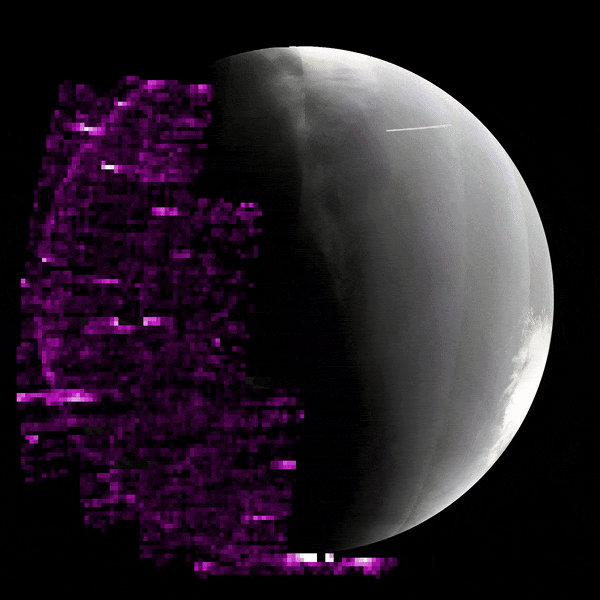Planets
NASA's Curiosity Rover Accidentally Discovers Sulfur Crystals on Mars
The rover’s wheel cracked open a rock and revealed pure elemental sulfur, which researchers have never seen on the Red Planet before
Astronomers Propose New Criteria to Classify Planets, but Pluto Still Doesn't Make the Cut
The new definition would define planets based on mass, rather than more ambiguous shape and size characteristics
This Nearby Exoplanet Is Hot, Dangerous—and Smells Like Rotten Eggs
Located about 64 light-years away from Earth, the world is the first place astronomers have detected hydrogen sulfide outside our solar system
Here’s What We’ve Learned About Saturn Since Cassini Entered Its Orbit 20 Years Ago
The Cassini-Huygens mission increased our understanding of the planet’s rings and moons
Jupiter's Signature Red Spot May Have Evolved More Than Once
The planet's massive storm, known as the Great Red Spot, seems to be different from a spot first observed at roughly the same location in the 17th century, a new study finds
Mars Was Hit With a Solar Storm Days After Earth's Aurora Light Show, NASA Says
Studying this event could hold lessons for scientists about how to protect astronauts from radiation on future trips to the Red Planet
Astronomers Discover Water Frost on Mars' Tallest Volcanoes
On early winter mornings, a thin layer of ice forms in craters atop the Red Planet's towering peaks, near its equator, according to a new study
These National Parks Are Hosting Astronomy Festivals in 2024
Get outside, ditch the light pollution and marvel at the cosmos on these protected public lands
Missed the 'Parade of Planets'? These Upcoming Alignments Will Likely Be Better, Anyway
Astronomers tempered expectations of the celestial event this week, pointing to others in the near future as more exciting opportunities for sky watchers
Venus Might Still Have Active Volcanoes, as Recent Lava Flows Suggest 'Ongoing' Eruptions
Astronomers have again discovered evidence of recent volcanic activity on Earth's sister planet in data from the 1990s
The Seven Most Amazing Discoveries We’ve Made by Exploring Jupiter
The giant planet is a world of extremes
Astronomers Discover an Atmosphere on a Hot, Rocky Exoplanet With an Ocean of Magma
It's the best evidence yet of an atmosphere on a rocky planet outside our solar system, researchers say, and studying the distant world could provide insight into Earth’s early days
The Seven Most Amazing Discoveries We’ve Made by Exploring Mercury
Only two robotic missions have made it to the Swift Planet, but they were crucial for upending many false assumptions of that sun-scorched world
Meteorites Are Becoming Harder to Find as They Sink Into Antarctica's Melting Ice
The disappearing space rocks are burying valuable clues into the history and composition of our solar system, according to a new study
Why We Love Eclipses
Two perspectives on the astronomical phenomenon that has fascinated humans for as long as we’ve been watching the skies
Titan's Massive Dunes May Be a Comet and Moon Graveyard From the Early Solar System
A new modeling study suggests the dark dunes on Saturn's largest moon are made of tiny particles created by crashing comets and moonlets billions of years ago
Oregon Is Now Home to the World's Largest Dark Sky Sanctuary
The Oregon Outback International Dark Sky Sanctuary covers 2.5 million acres in the southeastern part of the state
Mars Has an Unexpected Influence on Earth's Oceans and Climate, Repeating Every 2.4 Million Years, Study Finds
The gravitational interactions between Mars and Earth as they orbit the sun may have periodically promoted a warmer climate and changes in ocean circulation on our home planet
The Decimal Point Is 150 Years Older Than Previously Thought, Medieval Manuscript Reveals
A Venetian merchant used the mathematical symbol while calculating the positions of planets between 1441 and 1450
The Six Most Amazing Discoveries We’ve Made by Exploring Venus
Our sister planet’s cloudy exterior gave it an aura of mystery—until humanity developed the technology to probe past the veil
Page 1 of 17
:focal(1024x575:1025x576)/https://tf-cmsv2-smithsonianmag-media.s3.amazonaws.com/filer_public/38/bb/38bb7442-9862-40b8-89ff-a095e76d9abb/1-pia26309-curiosity-views-16x9-1.jpeg)
:focal(1051x567:1052x568)/https://tf-cmsv2-smithsonianmag-media.s3.amazonaws.com/filer_public/00/e2/00e2a283-4c55-4442-8304-5382614f5ef3/pia11800large.jpg)
:focal(3500x1983:3501x1984)/https://tf-cmsv2-smithsonianmag-media.s3.amazonaws.com/filer_public/1e/06/1e06b8cf-be0d-4df1-b7ab-53283700323d/hd_189733bs_atmosphere.jpg)
:focal(401x206:402x207)/https://tf-cmsv2-smithsonianmag-media.s3.amazonaws.com/filer_public/5f/4a/5f4a37a1-a7f2-4c3d-a1bb-54ac0c6d5f06/pia21345_modest.jpg)
:focal(827x543:828x544)/https://tf-cmsv2-smithsonianmag-media.s3.amazonaws.com/filer_public/30/00/3000c3d2-1519-4375-a014-bcc8b5d5fed1/pia21985orig.jpg)

:focal(845x459:846x460)/https://tf-cmsv2-smithsonianmag-media.s3.amazonaws.com/filer_public/ef/ff/efffec3e-d663-4701-8116-ec653f5d3ca9/perspective_view_of_frosty_olympus_mons.png)
:focal(1000x671:1001x672)/https://tf-cmsv2-smithsonianmag-media.s3.amazonaws.com/filer_public/30/c3/30c3cf9b-cc6f-4c33-888b-41af2a71fe2d/cf36e43e-596b-4104-a59e-9426cb826b92original.jpg)
:focal(4000x2095:4001x2096)/https://tf-cmsv2-smithsonianmag-media.s3.amazonaws.com/filer_public/03/64/03647ce0-0203-473c-8ba1-c5cc4725de7e/gettyimages-182910299.jpg)
:focal(625x351:626x352)/https://tf-cmsv2-smithsonianmag-media.s3.amazonaws.com/filer_public/d9/43/d9438ca3-e253-40a4-b6eb-142189c2657c/1-jpegpia00108.webp)
:focal(800x602:801x603)/https://tf-cmsv2-smithsonianmag-media.s3.amazonaws.com/filer_public/03/9e/039e6fe8-6beb-47e0-8f10-65cd3b2f5781/main_46577295485_94943f56db_o_web.jpg)
:focal(1000x571:1001x572)/https://tf-cmsv2-smithsonianmag-media.s3.amazonaws.com/filer_public/fc/90/fc9022fc-7d85-4a46-9b9c-826922f39b14/stsci-01hwqz4bjsgtdzc7fpdtvtnztc.jpg)
:focal(720x542:721x543)/https://tf-cmsv2-smithsonianmag-media.s3.amazonaws.com/filer_public/11/a8/11a8f779-8331-4682-8899-246f3c2815ba/main_esa_ssiow_iridescent_mercury_web.jpg)
:focal(930x700:931x701)/https://tf-cmsv2-smithsonianmag-media.s3.amazonaws.com/filer_public/2f/af/2faf224c-16ac-4efd-8bb9-e19576c87625/arctic2.jpg)
:focal(700x527:701x528)/https://tf-cmsv2-smithsonianmag-media.s3.amazonaws.com/filer_public/c9/98/c9981180-9665-4e4e-8390-93dcf586d711/smithmag-podcast-s02-ep04-eclipse-article.jpg)
:focal(762x434:763x435)/https://tf-cmsv2-smithsonianmag-media.s3.amazonaws.com/filer_public/77/28/772863a6-f8bc-4b47-ac3e-4ca78a6d115a/titan2.webp)
:focal(2048x1365:2049x1366)/https://tf-cmsv2-smithsonianmag-media.s3.amazonaws.com/filer_public/1e/79/1e79b464-d290-455a-890c-4150a9cae2a5/3_warner_valley_overlook_double_standing_milky_way.jpg)
:focal(681x512:682x513)/https://tf-cmsv2-smithsonianmag-media.s3.amazonaws.com/filer_public/0a/d7/0ad73452-f6d2-47e4-ad5b-d4bc1abae738/ezgif-3-0b922f8a81_cropped.jpg)
:focal(917x541:918x542)/https://tf-cmsv2-smithsonianmag-media.s3.amazonaws.com/filer_public/cb/50/cb50b6dd-b079-4d87-b6b8-eb1bfb1c5a71/1-s20-s0315086024000016-gr8_lrg.jpg)
:focal(639x481:640x482)/https://tf-cmsv2-smithsonianmag-media.s3.amazonaws.com/filer_public/ce/85/ce8574c1-9a3b-4dcc-a2f4-83d4bb0ce4e1/main_pia23791-venus-newlyprocessedview-20200608_cropped_web.jpg)